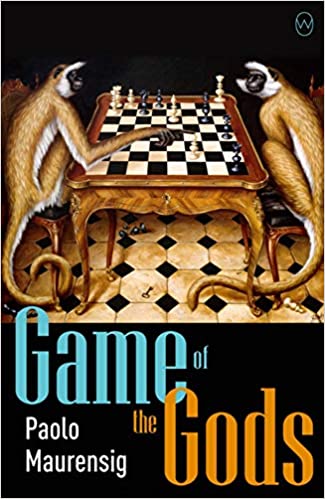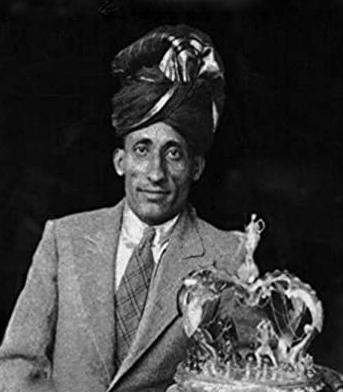“By now the newspapers have said everything about me that could be said, except the truth. The first condition that I place on you, therefore, is that you will fill this gap. If you promise to be sincere I will tell you every detail of my life, and describe how karma has acted on it since childhood. The second condition is that you not let anyone know where I am, at least not as long as I am alive.”—Malik Mir Sultan Khan, almost forgotten chess champion.
 It is no secret that Italian author Paolo Maurensig loves chess. His first novel, The Luneberg Variation, 1997, revolves around a chess match between a persecuted Jew and his Nazi persecutor. His 2018 novel, The Theory of Shadows, focuses on a possible international conspiracy involved in the death of Alexandre Alekhine, a world chess champion who died under suspicious circumstances in Portugal in 1946, a man suspected of “collaboration” by, variously, the Nazis, the French, and the Russians. The Game of the Gods, just released in the US, continues the chess focus, but this novel focuses primarily on the people who play chess and their feelings about playing – what the game means to them, not on the specifics of the game itself. As it develops, it weaves such a spell about chess and those who play it that even those, like me, who are not chess fanatics, can become totally absorbed in this story of one champion, known as Sultan Khan. His early life as a low-caste Indian, his experiences as he masters the game and begins to play on the international level, and the effects of the game on his personal life make him seem so “human” that the author is also able to elevate the narrative beyond the personal to include the history of the game, its mysteries, and the philosophies which give it religious status for many players.
It is no secret that Italian author Paolo Maurensig loves chess. His first novel, The Luneberg Variation, 1997, revolves around a chess match between a persecuted Jew and his Nazi persecutor. His 2018 novel, The Theory of Shadows, focuses on a possible international conspiracy involved in the death of Alexandre Alekhine, a world chess champion who died under suspicious circumstances in Portugal in 1946, a man suspected of “collaboration” by, variously, the Nazis, the French, and the Russians. The Game of the Gods, just released in the US, continues the chess focus, but this novel focuses primarily on the people who play chess and their feelings about playing – what the game means to them, not on the specifics of the game itself. As it develops, it weaves such a spell about chess and those who play it that even those, like me, who are not chess fanatics, can become totally absorbed in this story of one champion, known as Sultan Khan. His early life as a low-caste Indian, his experiences as he masters the game and begins to play on the international level, and the effects of the game on his personal life make him seem so “human” that the author is also able to elevate the narrative beyond the personal to include the history of the game, its mysteries, and the philosophies which give it religious status for many players.
The novel opens with the author introducing Sultan Khan, whose real name, Malik Mir Sultan Khan, was given to him to honor the Maharajah for whom his family worked. Sultan Khan, a real person, left behind a “luminous trail, [like] a shooting star: a dazzling radiance that precedes the most utter darkness, [and] if it were not for the testimony he himself gave to Washington Post correspondent ‘Norman La Motta,’ on the eve of war between India and Pakistan, we would not know anything about him other than the games documented in various tournament records of the time.” The only Asian player to achieve such extraordinary results would have vanished completely from history, except for his tournament records, if reporter “LaMotta” had not dedicated himself to finding his idol from childhood in hopes of writing his biography. Ironically, it was a scandal from the mid-1950s in which Sultan Khan was mentioned as a suspect which gave La Motta some new inspiration to keep searching, and he eventually found Sultan Khan, who demanded that he agree to certain conditions, given in the opening quotation of this review, before he would agree to be interviewed. What follows is a narrative that is partly true and partly imagined, as Sultan Khan tells his story and “Norman LaMotta” tries to learn everything possible before Sultan Khan’s imminent death.

Regarded at first as the goddess Parvati, bride of Shiva, the tiger soon became Kali, the bloodiest goddess in the pantheon.
The novel divides into several sections, each of which is fascinating in its own right. Sultan Khan, known then by his common name of Malik, spends his childhood in rural India, where a killer tiger targets his village. The village elders regard this tiger as “an emanation of the goddess Parvati, the bride of Shiva.” Before long, however, the tiger transforms into “the embodiment of the bloodiest goddess in our entire pantheon: the goddess Kali, who regularly demands a human sacrifice. Eventually, the tiger kills a baby and a young man, a sign it belongs to the demonic world, a conclusion which is further confirmed for Malik when it kills people close to him. While waiting for his master and a high level British friend to hunt and, hopefully, kill the tiger, Sir Umar Khan invites the villagers to approach him and express grievances and requests. Malik requests to learn chaturanga, the precursor of chess. Eventually, Malik is summoned to the palace and hired to work in the maharaja’s court as a servant but also as a chaturanga player with the prince. There he learns the rules and the etiquette, and eventually understands that learning the subtleties of chaturanga will teach him to “know himself…and be able to predict the fate of any battle.”

When Sultan Khan became stuck for a move during a tense game, Ganesha would appear to him with the answer.
He begins to win local tournaments, and before long, he accompanies his master to England, studies chess, and begins to win there, too. His “career was meteoric, like the luminous trail of a bengal light…[lasting] for three years or so.” Unfortunately, the social conflicts between the British and the Indians in that period lead to resentments when Malik begins to win often, including winning the British Chess Championship twice in a row, and though he continues to win, the game has lost its charm for him. When his master needs medical treatment, Malik learns to drive and gets a job working as a chauffeur at a British estate. It is there that he learns how chess can connect to warfare and how chess players, with their ability to think ahead, can be useful in predicting outcomes in battles. Eventually, he leaves England and the chess life, heads to New York, and befriends a blind, elderly woman who becomes his special mentor, a woman who lovingly teaches him to read and write, speak well, and pursue some new intellectual interests. The final section returns to the narrative of “Norman LaMotta,” and the ultimate fate of Malik Mir Sultan Khan.
The novel attempts to fulfill an extraordinary number of admirable goals, and it succeeds with many of them. It moves quickly and provides innumerable insights into chess, its history, and its connections to Indian spiritual karma, and it touches on issues related to India and its connections with the outside world. Its likable characters of varying cultures and different outlooks add breadth to the characterizations, themes, and visions of life. Ultimately, the author Maurensig’s confidential and relaxed, almost conversational, tone draws in the reader and makes even a newcomer to chess feel like part of the narrative. Though the novel would have benefited from a tighter plot with fewer locations and subplots, few novels these days have as much élan as this one does. I recommend it highly to those looking for some fresh insights into new worlds at a time in which many are desperately searching for a change of pace.
ALSO by Maurensig: A DEVIL COMES TO TOWN and THEORY OF SHADOWS
Photos: The photo of Sultan Khan appears on https://www.amazon.com
The pouncing tiger is found on https://www.pinterest.com
The Ganesha model may be found on https://www.123rf.com
The author’s photo is from http://www.paolomaurensig.it/
The 1930 Rolls Royce appears on http://greatentertainersarchives.blogspot.com



